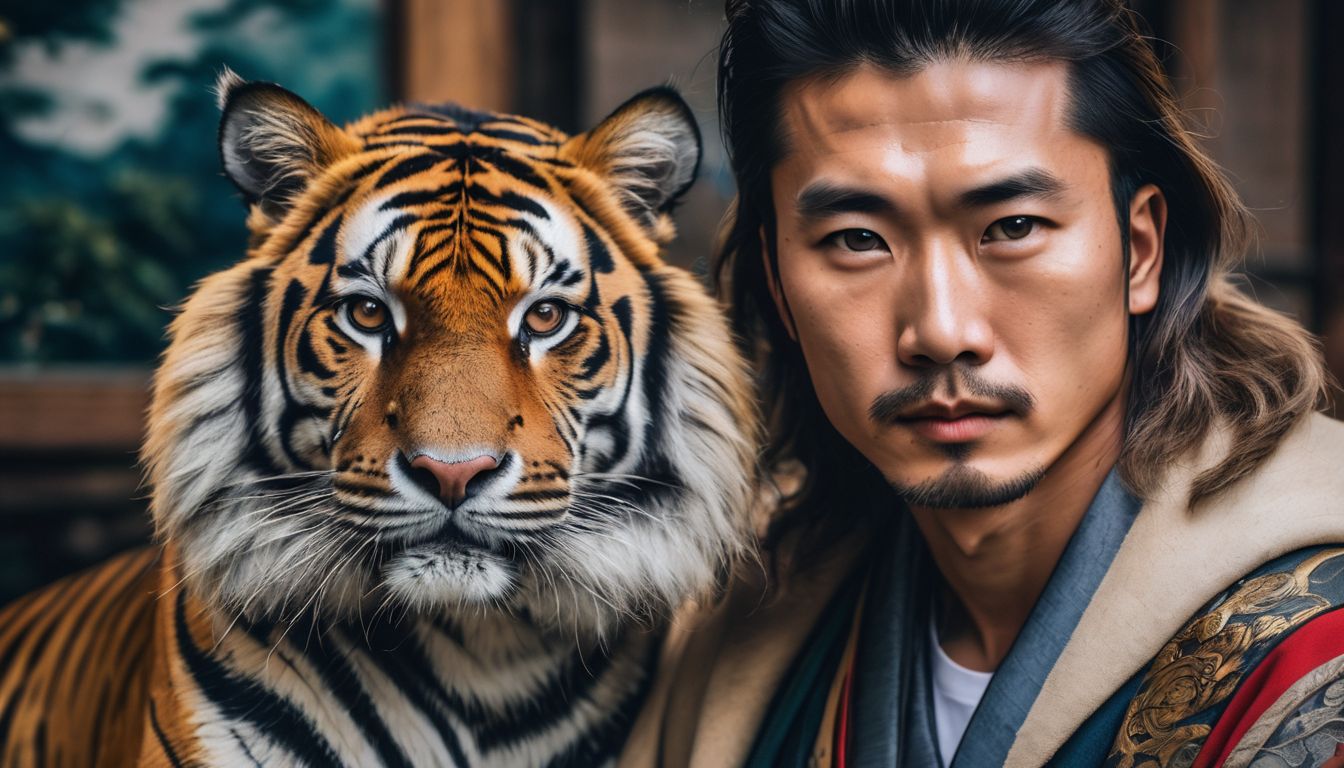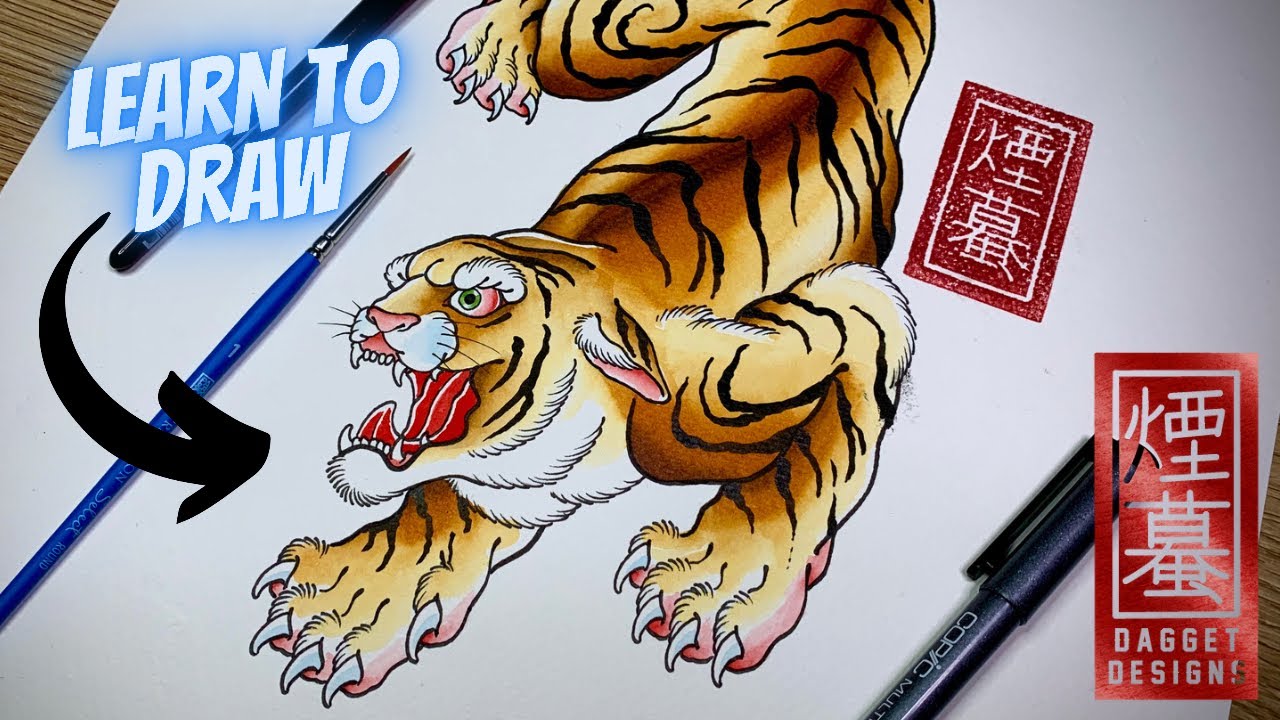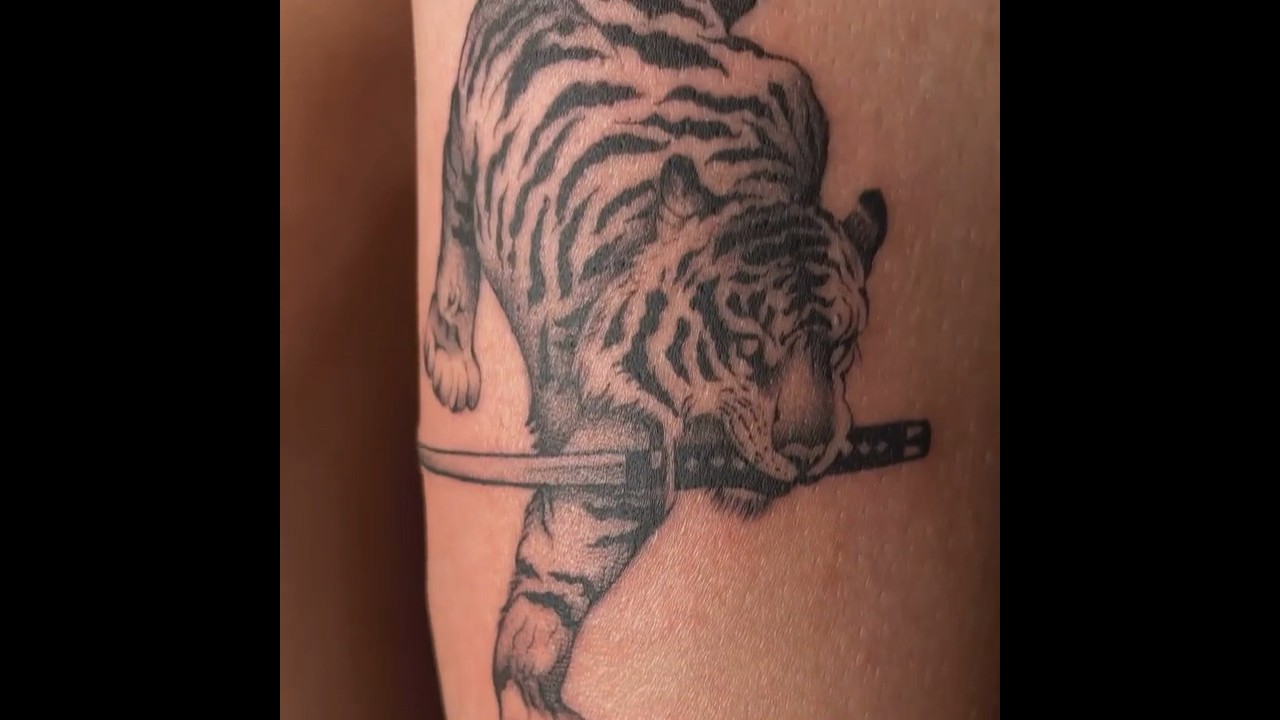Unraveling the Symbolism of Japanese Tiger Tattoos: A Powerful Blend of Art and Tradition
Create your own unique tattoos and art for your home
Have you ever wondered what lies behind the fierce beauty of Japanese tiger tattoos? These striking designs are not just cool artwork; they carry deep meanings inherited from centuries of tradition.
In this post, we’ll peel back the layers of history, symbolism, and art that make these tattoos so captivating. Discover a world where every line tells a story—let’s dive in!
Key Takeaways
- Japanese tiger tattoos symbolize strength, courage, and protection, and are rich with cultural significance dating back to ancient Japan. They often depict tigers among elements like bamboo or autumn leaves to highlight their connection with nature.
- Traditional techniques like tebori, a hand – poking method, are used alongside modern machines to craft these tattoos. Tebori allows for intricate line work and shading that elevates the artistry of each design.
- The colors in Japanese tiger tattoos have deep meanings: black represents power, red signifies passion and vitality, green denotes resilience and growth, while other hues add dynamism to the designs.
- Caring for a traditional Japanese tiger tattoo involves gentle cleaning, moisturizing regularly, protecting from sunlight during healing, wearing loose clothing over it to prevent irritation. Proper aftercare is crucial for maintaining vibrancy and longevity.
- The full – body designs of these tattoos use vibrant colors and dynamic compositions inspired by traditional Japanese art styles; they extend across large areas of skin to tell stories of bravery and spiritual protection.
The Fascinating History of Japanese Tiger Tattoos
Japanese tiger tattoos have a rich history in Japanese art, with early depictions dating back to ancient times. The rise of Japanese tiger tattoos was also influenced by non-native cultures, adding layers of complexity to their symbolism and significance.
Early depictions in Japanese arts
Tigers prowled across the canvas of Japanese history long before they danced onto skin as tattoos. These majestic creatures were painted on silk scrolls and carved into temple walls, where stories of their might and mystery unfolded.
Artists captured tigers amid bamboo forests or perched on rocky outcrops, symbols of power and wild beauty. Their images echoed through palaces and monasteries, inspiring awe in all who gazed upon them.
In traditional ukiyo-e woodblock prints, tigers leapt with an elegance that belied their ferocious nature. Calligraphers brushed the spirit of these mighty animals into poems, illustrating tales where tigers stood guard against evil spirits or represented the fierce winds sweeping across mountainsides.
Each stroke conveyed respect for the tiger’s role within the tapestry of Japanese mythology—a guardian beast commanding both fear and reverence from humankind.
Rise to prominence through non-native influences
After early depictions in Japanese arts, the symbolism of Japanese tiger tattoos rose to prominence through non-native influences. This was particularly evident during the Edo period when Japan opened its doors to outside interactions, leading to a fusion of artistic styles and techniques.
During this time, tattooing was greatly influenced by Chinese culture as well as European explorers’ accounts of encountering indigenous peoples with elaborate body art. As a result, Japanese tiger tattoos began incorporating elements from these external influences while still retaining their traditional meanings and aesthetic characteristics.
The influx of new artistic influences led to an evolution in the portrayal and techniques used in Japanese tiger tattoos. This shift resulted in more intricate designs, bolder lines, and an increased emphasis on color variations within traditional tattooing methods.
The Meaning and Symbolism of Japanese Tiger Tattoos
Japanese tiger tattoos symbolize power, strength, and protection in Japanese culture. Tigers are revered for their positive attributes and are often depicted in traditional Japanese art as a symbol of bravery and courage.
Power and strength
Japanese tiger tattoos are a bold embodiment of strength, courage, and protection. The traditional Tora tattoo symbolizes not only physical power but also the internal strength and determination of its bearer.
Tigers have been revered as symbols of bravery and resilience in Japanese culture for centuries. They serve as a reminder to confront challenges with fortitude and tenacity.
Tigers are considered protectors and symbols of courage in Japanese culture, encapsulating various qualities such as passion, ferocity, and unwavering bravery. These majestic creatures have been depicted surrounded by bamboo in traditional sleeve tattoos, symbolizing their strong connection to nature.
Protection
Tiger tattoos in Japanese culture symbolize protection, representing the guardian role of these majestic creatures. Tigers are revered for their ability to safeguard against negative forces, embodying strength and courage as protectors.
The traditional significance of Japanese tiger tattoos lies in their role as symbols of defense and resilience, imparting a sense of security to those who bear them.
The powerful symbolism associated with Japanese tiger tattoos stems from the deep-rooted belief that tigers possess the prowess to shield individuals from harm. These awe-inspiring designs serve as an emblem of fortitude and safeguarding, infusing wearers with a sense of assurance and vigilance.
Positive attributes of tigers in Japanese culture
In addition to their symbolism of protection, tigers in Japanese culture are revered for their positive attributes, representing courage, strength, and passion. Japanese tiger tattoos embody these qualities as a form of personal empowerment and resilience.
Tigers have long been regarded as protectors in Japanese folklore, symbolizing bravery and determination. Their significance extends beyond physical prowess to encompass mental fortitude and the ability to overcome obstacles, making them an enduring motif in traditional Japanese art and tattooing.
Tiger symbolism is deeply ingrained in the cultural fabric of Japan; they represent beauty, ferocity, and adaptability. These creatures serve as a reminder of the innate power within individuals while also signifying respect for nature’s strength.
The Aesthetics of Japanese Tiger Tattoos
Traditional Japanese tiger tattoos are known for their use of tebori, a hand-poking technique that creates unique textures and depth. The ink shades used in these tattoos hold deep cultural significance, while the intricate line work and boldness of the designs showcase the artistry and skill of traditional Japanese tattooing.
Traditional techniques: Tebori vs modern machines
While modern machines have streamlined the tattooing process, tebori, the traditional Japanese hand-poking method, continues to hold a significant place in the art of Japanese tiger tattoos.
The tebori technique involves using a set of needles attached to a long rod which is manually driven into the skin. This method allows for more control and precision, resulting in exceptionally intricate line work and shading that brings out the depth and beauty of Japanese tiger tattoo designs.
Modern machines offer efficiency but may lack the subtle nuances achieved through tebori. These machines are capable of creating precise lines and vibrant colors that appeal to those seeking a quicker and less painful experience.
Use of traditional ink shades and their significance
Traditional Japanese tiger tattoos are distinguished by the use of specific ink shades, each carrying its own significance. The black ink represents strength and power, accentuating the boldness of the design.
Red ink symbolizes passion and vitality, adding a dynamic element to the tattoo. Additionally, green ink is often used to depict bamboo and nature elements, signifying resilience and growth in Japanese culture.
The choice of traditional ink shades for Japanese tiger tattoos holds deep cultural meanings. Black conveys the ferocity and dominance of tigers in nature, while red embodies their fiery spirit.
Intricate line work and boldness
Transitioning from the traditional techniques and ink shades used in Japanese tiger tattoos, it’s essential to appreciate the intricate line work and boldness that are defining features of these designs.
The attention to detail in creating fine lines is a testament to the skill and precision of the tattoo artist. Each stroke contributes to the overall visual impact, showcasing the artistry and dedication involved in crafting these striking pieces.
Additionally, the boldness of Japanese tiger tattoos conveys strength and power, making a lasting impression on both the wearer and those who view them.
The use of precise lines adds depth and dimension to Japanese tiger tattoos, emphasizing every muscle, fur texture, and expression with remarkable clarity. This meticulous approach captures not only the physical attributes but also embodies the symbolism associated with tigers in Japanese culture – their unwavering courage and protective nature stand out boldly through every intricate line.
Showcase of Japanese Tiger Tattoo Designs
Experience the beauty and intricacy of full-body designs, colorful variations, and traditional Japanese style tiger tattoos. Discover the artistry behind these stunning tattoo designs that showcase the rich symbolism and tradition of Japanese culture.
Read on to explore more about this captivating art form.
Full-body designs
Japanese tiger tattoos often span the entire canvas of the body, portraying the majestic creature in all its glory. The full-body designs intricately capture the strength and power associated with tigers, showcasing their dominance and ferocity.
These elaborate tattoos utilize every inch of skin to create a stunning visual narrative, symbolizing courage, protection, and resilience. Incorporating vibrant colors and dynamic compositions, these designs bring to life the rich history and symbolism deeply rooted in Japanese culture.
Tattoo enthusiasts seeking an immersive experience can opt for these extensive designs that not only exemplify traditional Japanese art but also embody the timeless allure of tiger symbolism.
Colorful variations
Japanese tiger tattoos often incorporate vibrant and striking colors, adding a dynamic visual appeal to the traditional design. Artists utilize bold hues such as red, orange, and yellow to convey energy and power associated with the tiger.
These colorful variations further enhance the symbolism of strength and vitality represented by the majestic animal. Additionally, blue and green tones are sometimes incorporated to symbolize tranquility or natural surroundings, providing a nuanced representation in Japanese tiger tattoo art.
In traditional Japanese tattoo designs, colorful variations are used skillfully to portray the tiger amidst its native habitat or in stylized depictions that highlight its regal presence.
Traditional Japanese style
Japanese tiger tattoos in the traditional style are characterized by bold lines and vibrant colors. These designs often feature intricate details, such as swirling clouds, raging seas, or blooming flowers to complement the fierce yet graceful presence of the tiger.
The traditional tebori technique, involving hand-tapping ink into the skin with a bamboo rod, adds an extra layer of cultural significance and craftsmanship to these timeless creations.
The use of natural ink shades like black, red, green, and yellow holds deep symbolic meaning in Japanese culture and further enhances the visual impact of these powerful designs.
The traditional Japanese approach to creating tiger tattoos pays homage to centuries-old art forms with meticulous attention to detail while capturing the strength and beauty associated with this revered animal.
Caring for Your Traditional Japanese Tiger Tattoo
Proper aftercare for your traditional Japanese tiger tattoo is crucial to maintain its vibrancy and longevity. Traditional inks may require unique care methods to ensure the tattoo stays true to its original charm.
Initial aftercare steps
Caring for your traditional Japanese tiger tattoo begins with:
- Gently washing the tattooed area with mild, fragrance – free soap and lukewarm water to remove any ointment or blood.
- Patting the area dry with a clean, soft cloth, avoiding abrasive materials that could irritate the skin.
- Applying a thin layer of fragrance – free moisturizer to keep the tattooed skin hydrated and promote healing.
- Avoiding direct sunlight and swimming for at least two weeks to prevent fading and infection.
- Wearing loose – fitting clothing to minimize irritation to the tattooed area during the healing process.
- Refraining from scratching or picking at scabs to prevent damaging the tattoo and risking infection.
- Following any additional aftercare instructions provided by your tattoo artist for optimal healing and preservation of your traditional Japanese tiger tattoo.
Maintaining vibrancy and longevity
To maintain the vibrancy and longevity of your traditional Japanese tiger tattoo, it’s essential to prioritize proper aftercare. Regular moisturizing with a fragrance-free lotion will help preserve the vividness of the ink and prevent any fading over time.
Shielding your tattoo from prolonged sun exposure is crucial in preserving its colors and preventing them from dulling prematurely. Additionally, ensuring that your skin remains healthy by keeping it hydrated will contribute to maintaining the integrity of your tattoo.
Furthermore, opting for touch-ups as needed can keep your Japanese tiger tattoo looking fresh and vibrant for years to come. These simple yet effective measures will uphold the beauty and symbolism of your traditional Japanese tiger tattoo, adding an enduring charm to this powerful representation of strength and tradition.
Unique charm of traditional inks
To maintain the unique charm of traditional Japanese tiger tattoos, artists use specialized inks that have been passed down through generations. These inks are made from natural materials and offer a striking color palette ranging from deep blacks to rich shades of red, green, and blue.
The use of these traditional inks not only adds depth and vibrancy to the tattoo but also holds cultural significance as they symbolize the connection to ancient Japanese artistry and tradition.
The process of creating ink for traditional Japanese tiger tattoos involves precision and expertise, with each pigment carefully mixed to achieve the desired hue. This meticulous approach results in colors that age beautifully over time, maintaining their integrity even after years of wear.
Conclusion
In conclusion, Japanese tiger tattoos hold a deep-rooted symbolic significance within the realm of art and tradition. The rich history and cultural importance attached to these powerful designs make them timeless representations of strength, courage, and protection.
From their early depictions in Japanese arts to the intricate aesthetics of traditional tattoo techniques, these designs embody a captivating blend of artistry and symbolism. Embracing a Japanese tiger tattoo not only showcases artistic beauty but also encompasses profound meanings that resonate with the wearer’s spirit for ages to come.
FAQs
1. What does a Japanese tiger tattoo symbolize?
A Japanese tiger tattoo represents strength, courage, and protection against bad luck or evil spirits, blending art and tradition in its symbolism.
2. How important are tiger tattoos in Japanese culture?
Tiger tattoos hold great significance in Japanese culture as symbols of fearlessness and power within the rich history of traditional tattoos.
3. Can you explain the meaning behind traditional Japanese tiger tattoo designs?
Traditional Japanese tiger tattoo designs often mean good fortune and are seen as guardians, illustrating deep-rooted symbolism in animals within Japanese art traditions.
4. What kind of stories do Japanese tiger tattoos tell?
Japanese tiger tattoos carry stories from ancient times that embody attributes like bravery and nature’s raw force, reflecting the history and significance encapsulated in their symbolism.
5. Are there specific traditions followed when getting a Japanese tiger tattoo?
Yes, there are special traditions followed which show respect for the cultural heritage; these include choosing symbolic elements that align with personal beliefs or desires for one’s life journey.










